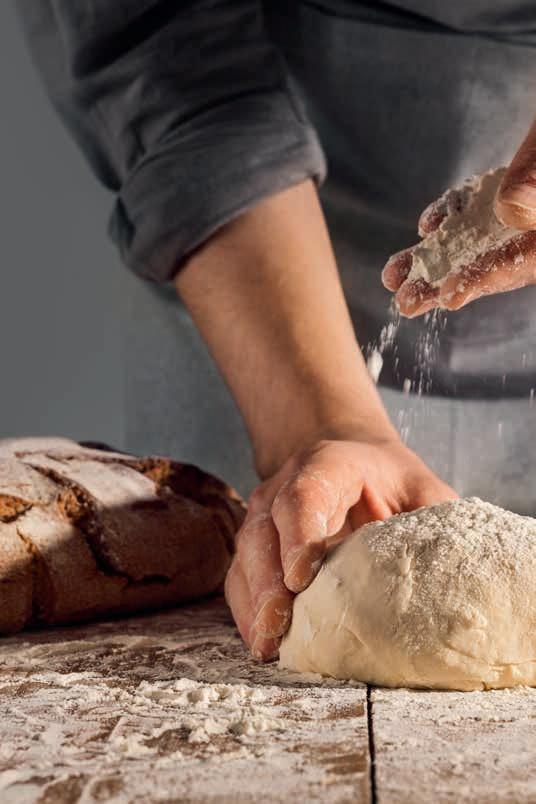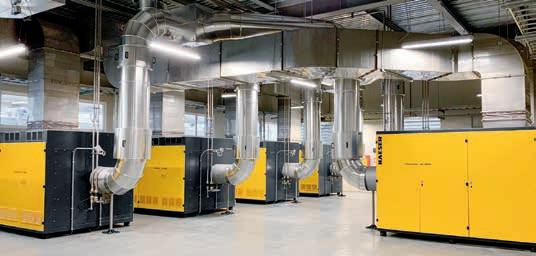
4 minute read
Sustainability in the food
Satisfying the needs of today’s generation without jeopardising the opportunities of future generations. That’s the order of the day and how the Italian yeast specialist AB Mauri views sustainable development – the goal is to create synergies between economic, ecological and social sustainability. In line with this company philosophy, a comprehensive energy savings project was recently implemented, as part of which the blower station was also completely modernised.
AB Mauri is part of the Associated British Foods plc (ABF) international group based in London and is a leading global manufacturer of yeast and ingredients for bakeries, patisseries and pizzerias, with over 7,000 employees and 52 locations in 32 countries. In Italy, AB Mauri operates two plants, one in Cologna (province of Brescia) and the other in Casteggio (province of Pavia), employing a total of approximately 250 people.
Sustainability and energy savings were the main goals of the complex optimisation process recently implemented at the Casteggio location. Accordingly, the yeast aeration process was also closely examined. Thanks to the excellent cooperation and partnership that developed between KAESER and AB Mauri’s engineering team, a finely tuned technical solution was found, with which the yeast specialist is highly satisfied.
Sustainability and energy savings
Here at the Casteggio location, near the northern Italian city of Pavia, everything revolves around the production of yeast, which is created by the growth of yeast cultures in a primarily molasses-based nutrient solution. The molasses contains not only sugar but also nutrients such as vitamins and trace elements, which, together with water, form the ideal nutrient medium for yeast cultures. An important prerequisite for the yeast cells to multiply exponential- ly is the addition of oxygen to the nutrient solution. This delicate biological process, critical to yeast production, lies at the heart of production, enabling the use of modern technology to significantly increase efficiency potential.
As a rule, fermentation processes in foodstuffs are based on precise process air profiles: the need for oxygen is based on the growth of microorganisms, i.e. as the volume gradually increases, more oxygen is required. Blower air demand therefore varies during precisely defined phases within the process, which can take several hours. The key word here is ‘control’. Moreover, the quality of the blower air plays an important role, as it is directly introduced into the production process.

The SIGMA AIR MANAGER 4.0 communicates with the in-house management system for demand-oriented, pinpoint adjustment.
Precision control
After considering and analysing all data and process air requirements, a total of 19 KAESER PillAerator turbo blowers were selected in two versions, the LP8000 (150 kW) and the LP14000 (300 kW). Thanks to the turbo blowers’ infinite speed control, flow rate can be variably adjusted to meet actual demand at any time. This not only enables straightforward process control, but also reliably prevents potential energy losses due to over-aeration. On-board sensors continuously monitor key operating parameters such as flow rate, pressure, speed, and temperature and interact with the master controller and inhouse control centre to enable implementation of precise adjustments as needed. To ensure smooth interaction of the 19 turbo blowers, a total of seven master controllers from KAESER and six routers were installed. Furthermore, the maintenance-free drive ensures even greater cost efficiency: since the contact- and lubricant-free magnetic bearing motor operates completely wear-free, there is no need for oil and bearing changes, and maintenance is limited to simple air filter changes.

The “Hall of Fame” with 19 KAESER PillAerator turbo blowers.
Complete satisfaction
Installation, connection, and commissioning of the new blower station were highly complex due to its size. Despite this, everything went smoothly thanks to professional planning from all parties involved, and, most importantly, this was achieved without any unwanted production downtime. The close collaboration between KAESER and AB Mauri’s engineering team made it possible to identify the most efficient solution in terms of plant layout, energy consumption and the most powerful machine combination. The overall result has helped save more than 15 percent of the entire plant’s electricity consumption.








